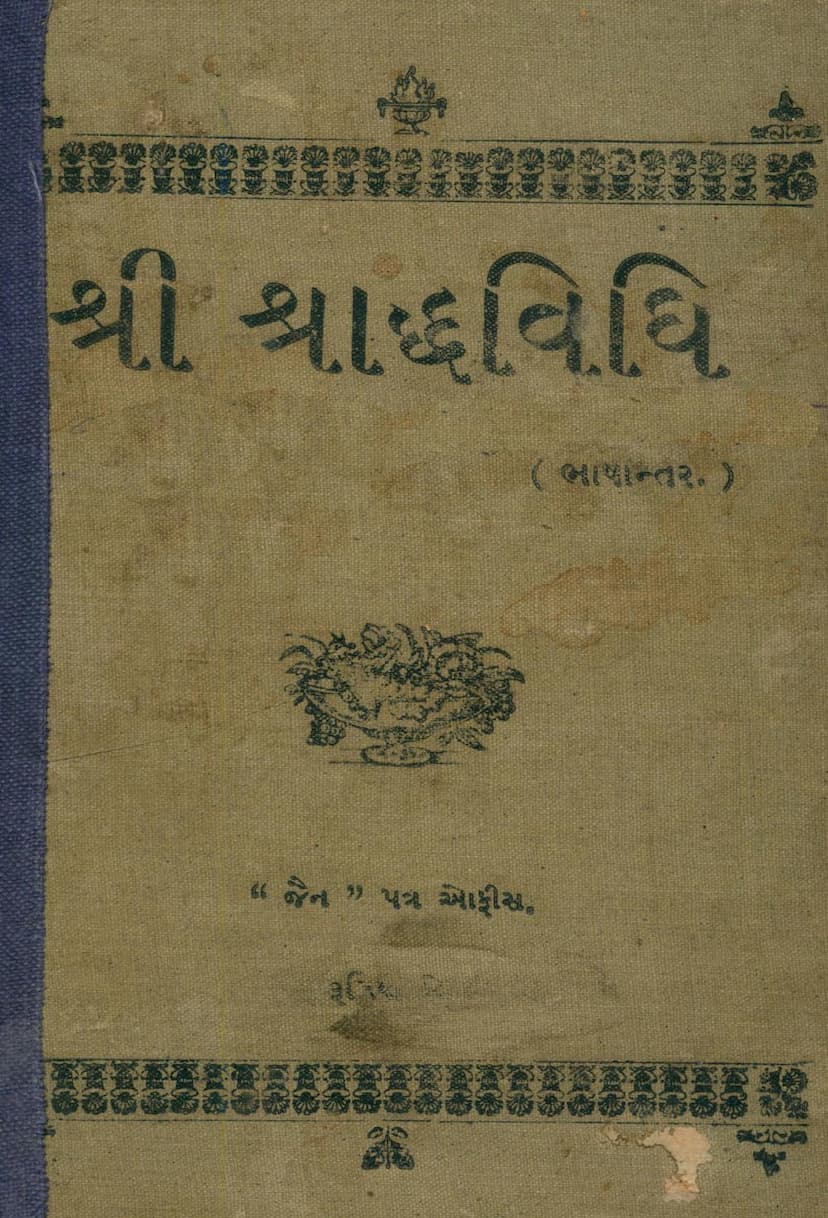Shraddh Vidhi
Added to library: September 2, 2025

Summary
The book "Shraddh Vidhi" (શ્રાદ્ધવિધિ), published by "Jain Patra" in Ahmedabad, is a comprehensive guide to the duties and practices of a devout Jain layperson (Shravak). The catalog link provided (https://jainqq.org/explore/022209/1) indicates it's a significant religious text.
Key aspects and themes based on the provided pages:
-
Dedication: The book is dedicated to the memory of Sheth Dharamchand Udaichand of Bombay, who passed away on January 19, 1904. This suggests the book was published around that time, likely in 1904 (Samvat 1960).
-
Purpose and Motivation: The preface explains that this translation was undertaken because previous Gujarati translations of the "Shraddh Vitra" (likely a core text on lay Jainism) were either too expensive or not accessible enough for the common person. The publisher aims to make this essential guide available at a nominal price, even gifting it to subscribers of the "Jain Patra" newspaper. The goal is to educate Jains on their duties from birth to death, fostering a better understanding of their religion and responsibilities towards their community.
-
Content Overview (from the Index): The book is vast, covering a wide range of topics essential for a Jain householder. The index (Visayank - વિષયાંક) reveals a detailed structure, including:
- Mangalacharan (Invocation): Standard auspicious beginnings.
- Names of Scholars: Likely referencing the lineage of scholars or commentators.
- Qualities of a Shravak: Defining the ideal layperson.
- Illustrative Stories (Drishtanta): Numerous narratives are used to explain religious principles, featuring figures like Bhuvanbhanu Kevali, Varahamihir, Gamandi's son, Shukraj, Sur Sundar Kumar's wives, Ambada Parivrajaka, Chandala, Kumarpal Raja, Dahad Mantri, Dashanbhadra Raja, and others. These stories are crucial for conveying moral and ethical teachings.
- Rituals and Practices:
- Daily duties (morning routines, waking up, what to do upon waking).
- Navkar Mantra recitation and its benefits.
- Religious observances like Dharmagārikā (vigils), vows (Niyam), and repentance (Pratikraman).
- Dietary rules: Classification of foodstuffs (sachitta, achitta, mishra), rules about water, cleaning rice, etc.
- Purity of items (dravya shuddhi) and intention (bhava shuddhi).
- Temple rituals: How to approach the temple, types of worship (Ang Puja, Agra Puja, etc.), musical instruments and dances used in temples, rules for idol worship, and the significance of different types of worship.
- Ethical conduct: Dealing with wealth, honest trade, truthfulness, friendship, avoiding gossip, and managing finances.
- Family and social life: Marriage, raising children, treating elders, and dealing with societal issues.
- Specific observances: Fasting (Pausadh), specific meal restrictions (Navkashi, Parshad), rules for different times of the day.
- Philosophical Concepts: Explanations of concepts like Nama (name), Sthapana (establishment), Dravya (substance), and Bhava (state/feeling) related to Jain practice.
- Repentance and Atonement: Detailed procedures for Pratikraman and Kaussarg.
- Cosmology and Astronomy: Mentions of elements and celestial bodies (Earth elements, Moon, Sun Nadis).
- Hygiene and Daily Life: Rules for bathing, brushing teeth, etc.
- Key Jain Principles: Emphasis on Ahimsa (non-violence), Dharma (righteousness), Artha (wealth), and Kama (desire) in the context of a householder's life.
-
Biographical Sketch of Sheth Dharamchand Udaichand: A significant portion of the initial pages are dedicated to the life of the patron, Sheth Dharamchand Udaichand. The text highlights his charitable nature, his involvement in religious activities, his business acumen (jewellery), his early start in business, and his commitment to supporting Jain causes. It emphasizes his exemplary life and the impact of his virtues. His photograph is also included, suggesting the book aims to inspire readers through his example.
-
Authoritative Sources: The text references Muni Buddhisagar, Munishri Mohanalalji, Muni Harak Muni, Muni Muni, and the work of authors like Pandit Hemchandrasuri, indicating it draws from established Jain literature and traditions.
-
The "Jain Patra": The publisher, "Jain Patra" office, seems to be a newspaper or periodical dedicated to Jain welfare, aiming to spread religious knowledge and promote community upliftment.
In essence, "Shraddh Vidhi" is a foundational Jain text that aims to guide individuals in living a righteous and devoted life according to Jain principles, emphasizing adherence to rituals, ethical conduct, and the pursuit of spiritual merit throughout their lives. The use of stories and illustrative examples makes the complex teachings accessible and relatable.